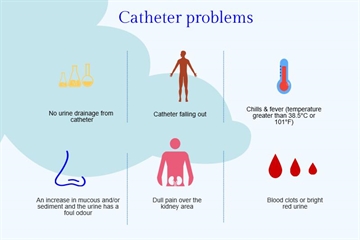What to expect
You will be given some supplies so that you can look after your catheter. You will probably have the catheter in place for 1-2 weeks. You will be given an appointment to have the catheter removed
4
"I’d hardly move and the first five or so days I was trying to lay on my back, I wasn’t brave enough to turn over".The hospital staff may arrange for a community nurse to contact you. This service varies depending on where you live in the world. If you are expecting to be contacted by a community nurse and this does not happen after 24 hours, try phoning them or your GP. If you have a concern about your catheter and are unable to contact the community staff, then you should ring the hospital ward that discharged you for advice.
Do not feel that you must manage alone when you go home – call someone if you need help or advice. Health care professionals very often help people at home with catheters. Most men report that with help and advice they were able to look after their catheter at home.
3
“I was given instruction yes, the ward nurse gave me the instruction ... I managed that. It was uncomfortable, you move sometimes and it’s not a natural thing to have a tube in so it was uncomfortable but I had a leg bag strapped on my leg and that stayed there … and I changed that once during the course of the two weeks and then I had night bags that I attached to it which were disposable. Yes I managed that perfectly. I had no problems with it.”
What can I do?
Look after your catheter as you have been shown and watch out for any problems. The most common of these are blockage and infection.
Whilst you have the catheter in place you are at a greater risk of developing a urinary tract infection (also called a UTI).
Contact your community nurse or GP immediately if you experience any of the following symptoms:
(Click on the picture to enlarge it)
2
Some handy tips for looking after your catheter at home:
-
Wash your hands before and after handling your drainage bag or catheter
-
Check that there are no kinks or bends in the tubing to stop flow
-
Keep the urine collection bag below the level of your bladder
-
Tape the catheter on the thigh to prevent tension or use a tubing support device
-
Shower with your catheter and urine collection bag in place if you wish to
-
Avoid sexual intercourse until your catheter is removed
Anything else I need to know?
You may be sent home with a large collection bag (night bag) rather than leg bags. If this is hindering your daily activities try using smaller, leg bags that can be attached to your lower leg or thigh. How you get hold of collection bags and other catheter equipment depends on where you live. In the UK ask your community nurse or your GP to prescribe items for you.
At night, large urine collection bags should be hung on the side of the bed or a purpose-made night bag holder/stand. You may be given one of these when you leave hospital. If not, some men improvise using a coat hanger under the mattress to secure the bag or by placing the collection bag in a bucket or a washing up bowl. You just need to ensure the collection bag is hanging at a lower level than your bladder.
Hear Laurence talk about how he managed his night bag:
Remember, if you are undergoing treatment for cancer in the UK or are receiving treatment for the side effects of current or previous cancer treatment, your prescription costs are free.
Read what will happen next in: